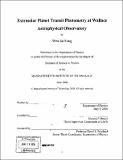| dc.contributor.advisor | Richard P. Binzel. | en_US |
| dc.contributor.author | Fong, Wen-fai | en_US |
| dc.contributor.other | Massachusetts Institute of Technology. Dept. of Physics. | en_US |
| dc.date.accessioned | 2009-01-30T16:49:10Z | |
| dc.date.available | 2009-01-30T16:49:10Z | |
| dc.date.copyright | 2008 | en_US |
| dc.date.issued | 2008 | en_US |
| dc.identifier.uri | http://hdl.handle.net/1721.1/44460 | |
| dc.description | Thesis (S.B.)--Massachusetts Institute of Technology, Dept. of Physics, 2008. | en_US |
| dc.description | Includes bibliographical references (p. 42-43). | en_US |
| dc.description.abstract | Extrasolar planet transit photometry is a relatively new astronomical technique developed over the past decade. Transit photometry is the measurement of a star's brightness as an orbiting planet passes in front of the star as seen from the Earth. Recently, members of MIT's Planetary Astronomy Lab (PAL) have launched an observing program for extrasolar planet transits at Wallace Astrophysical Observatory (WAO), which houses the 24-inch telescope used in this work. The purpose of this thesis is to enable students and faculty to easily perform transit photometry at WAO and assess the feasibility of transit photometry there. The PAL extrasolar planetary database currently has 36 planetary candidates, 23 of which are observable at WAO due to their positive declinations 6 (in the Northern celestial hemisphere). The maintenance of this database is described. Prediction methods used in Mathematica to determine when transits will occur at WAO for a given period of time are discussed. The transits at WAO are prioritized based on frequency of transit, transit depth and celestial location of parent stars, using the prediction period of 01-20-2008 to 05-30-2008. This prediction period is compared to four others spanning 2007-2009. These results suggest that the best planetary candidates at WAO for the fall are XO-3b, WASP-lb and HAT-P-6b and for the spring are HAT-P-3b, TrES-3 and XO-3b. A typical observing plan is produced based on the planetary candidate TrES-3, including finder charts for the highest frequency transiting planets in Spring 2008. Data reduction and analysis using either the standard IDL routine phot or the "Make_Lightcurve.nb" Mathematica notebook are described. A partial transit of XO2b taken at WAO is presented. Given WAO's recent upgrade by PAL along with the data presented here, the feasibility for successful extrasolar planet transit photometry projects at WAO is high. | en_US |
| dc.description.statementofresponsibility | by Wen-fai Fong. | en_US |
| dc.format.extent | 60 p. | en_US |
| dc.language.iso | eng | en_US |
| dc.publisher | Massachusetts Institute of Technology | en_US |
| dc.rights | M.I.T. theses are protected by
copyright. They may be viewed from this source for any purpose, but
reproduction or distribution in any format is prohibited without written
permission. See provided URL for inquiries about permission. | en_US |
| dc.rights.uri | http://dspace.mit.edu/handle/1721.1/7582 | en_US |
| dc.subject | Physics. | en_US |
| dc.title | Extrasolar planet transit photometry at Wallace Astrophysical Observatory | en_US |
| dc.type | Thesis | en_US |
| dc.description.degree | S.B. | en_US |
| dc.contributor.department | Massachusetts Institute of Technology. Department of Physics | |
| dc.identifier.oclc | 297175838 | en_US |
